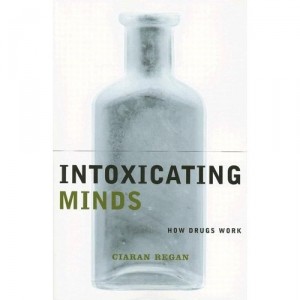For anyone interested in drugs, no matter the aspect (substance rehabilitation, public policy, cultural studies, etc.), it seems wise to learn at least a little bit about pharmacology. Pharmacology is the study of how drugs work in the body and the brain. It’s a rapidly developing field that could be the key to solving all sorts of problems – Alzheimer’s Disease, schizophrenia, depression, and so on. It tells us how drugs work in terms of their effects in our brains and on our behavior.
For a wide-ranging and colorful introduction to pharmacology, you can rely on Professor Ciaran Regan’s book “Intoxicating Minds: How Drugs Work.” I learned quite a bit about drugs both legal and illegal. Alcohol, for example, unlike many other drugs, does not have a specific receptor in the brain that it acts upon. It basically affects the entire nerve cell system. Benzodiazepines, on the other hand, have very specific effects. They bind on what is known as the GABA (gamma-aminobutyric acid) receptor and enhance the binding ability of the GABA neurotransmitter. Though both alcohol and benzodiazepines are colloquially known as “downers,” it’s obvious that they work in extremely different ways.
[caption id="attachment_807" align="alignright" width="300" caption=""Intoxicating Minds: How Drugs Work" by Ciaran Regan."]

[/caption]
Although I understand pharmacology better than I did before reading this book, it’s still a challenging and complicated field of study. If you really want to understand pharmacology, you’re going to have to study and read far more academic texts than this one. (Keep in mind that I came to the book with zip knowledge of pharmacology, though.) For some people, Russian novels make them wish they had a list of the characters’ first, middle, and last names; in my case, this book made me wish for an illustrated list of key definitions that I could
buylevitra refer back to as the book moved from drug class to drug class.
While you won’t get a degree in pharmacology from reading the book, you will learn a lot about the development of drugs and their use, both ancient and modern. A great deal of time is spent on mood disorders and schizophrenia, which yields some insights and draws attention to the upsetting fact that still, we just don’t get it – a full understanding of schizophrenia and depression still elude our grasp. My favorite sections covered how psychoactive drugs may’ve been involved in mankind’s first cave paintings, how the placebo effect may (or may not) work, and how plants themselves naturally contain benzodiazepines and other psychoactive substances and how those substances may regulate a plant’s own functions and in turn have influenced natural selection when it comes to human development.
The last bit is the most fascinating to me, and most reflect the author’s goals for this book. How in evolutionary history have drugs influenced our social organization and affected the development of our genetic code? Professor Regan is clear from the very beginning that he has no answers, just questions, and a lot of information (my favorite tidbit – did you know you can get benzodiazepines from cows’ milk, as a result of the way their body processes certain grasses? Presumably not enough to blame a failed
urine drug test on milk, though – it’s no poppy seed bagel). Any of the chapters in the book could easily be expanded into a full book and be worth reading. For the curiosity it inspires alone, “Intoxicating Minds” is well worth your time.
Check out the book's homepage at the
Columbia University Press site.
Learn more about the author by visiting Professor Ciaran Regan's page at the
University College Dublin.
- Book review by Robyn Schelenz.